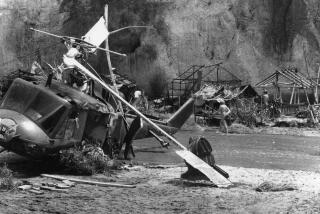KAMIKAZE DRIVERS : In the Long Run, Who Can Say for Sure What Made Them Do It?
- Share via
‘Twas a mid-late afternoon on Melrose, as the story goes , when our path was first crossed by one Darren Stroh. Just twenty-and-two, he was about to die and only he and his God know the reasons why.
*
My husband and I were driving south, down Vermont toward the 101, hurrying to beat closing time at the bank. Crossing Melrose, we heard sirens scream. A little red VW Cabriolet with a white top sped toward us, followed by a dozen California Highway Patrol and LAPD cars. Six helicopters buzzed overhead.
We thought we’d inadvertently driven onto a movie set and into a chase scene. But after hasty discussion, we decided that this was real.
As traffic crept to a stop, we pulled over to the right. The VW cut through a corner gas station, zipped alongside us and then zagged in front of us. The sandy-haired young driver gripped the wheel, coolly smoking a cigarette, as he monitored the side mirror, the rear-view, then the road ahead. He drove with such authority that he seemed to be leading the officers instead of running from them. He raced east on Clinton, enforcement vehicles in his exhaust.
On that third morning of January, 1992, unemployed electrician and murder suspect Darren Stroh started a 300-mile run from Los Banos with two rifles and a double-barreled shotgun taken from his granddad’s home up in Foots Creek, Ore., cruisin’ I-5 for San Diego till his ’78 Toyota sputtered and died. Then, responding to Stroh’s “Help” sign, good Samaritan David Baker offered him a jump. When the Toyota wouldn’t start, an impatient Stroh killed Baker with two shotgun blasts, then took his Nissan.
Around Coalinga, Stroh commandeered a VW (tags: KRUL FA8) and continued south through Bakersfield, where the CHP spotted and trailed him all the way into L.A., off the 101 and into our lives.
During our 10-minute crawl on the freeway, we speculated on the demons driving that VW. Exiting north on Mission, we heard screaming sirens. “Not again,” my huz groaned. The red and white bug weaved through a gas station lot, zagged into the intersection, passed in front of us, swerved due north and careened around a large triangular island, zooming east, The Law and news choppers dead on his tail.
“What are the odds of his crossing our path twice in one day?” we marveled, as the light changed thrice and we fought the urge to join the hunt. We heard the pop-pop of gunshots. We opted for the bank. Within the hour, Stroh was a footnote to local folklore.
Believing that the media frenzy caused by Stroh’s run spawned copycat car chases, I recently contacted CHP Officer Christine Rogers, public affairs field coordinator in Sacramento, who generously provided scads of statistics.
The total number of CHP-related chases jumped from 967 in 1991 to 1,341 last year. And when I divided the state roughly at Los Banos-Merced, I discovered that the number of chases in the Southland from January to July of this year surpassed the number up north, 2 to 1.
All of this may be flimsy evidence, but I suspect the live broadcast of Stroh’s run inspired other motorists, especially some of the 20-odd who wound up dead in 1992, to try to outrun police.
But what does make them run? Statewide figures for all law-enforcement agencies in 1992, the CHP included, reveal that only 29% of all chases were motivated by felonies and only 15% by misdemeanors such as driving under the influence. Surprisingly, 54% started with minor infractions.
*
‘Twas nobody’s guess that the story would end southbound on the 405, where Stroh played possum behind the wheel, then called out the action when he went for his steel. In the olden days, they would’ve said he was slow on the draw and that’s suicide, going down against The Law. Shots were fired. One man expired. All of twenty-and-two, and he chose to die. But only God and Darren Stroh know the reasons why.






